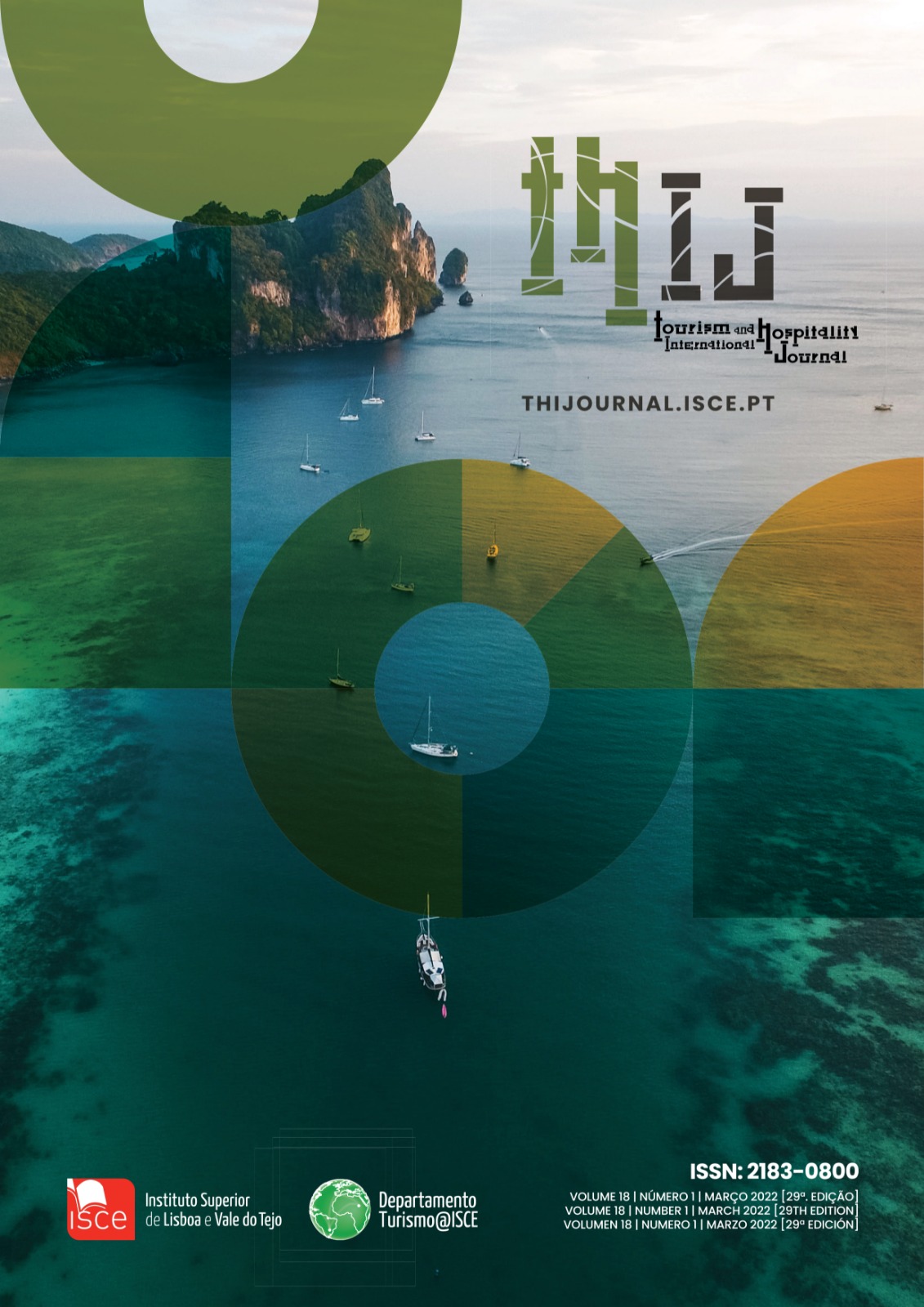Potencialidad del turismo gastronómico de la Comunidad Autónoma de Galicia
DOI:
https://doi.org/10.57883/thij18(1)2022.30919Resumo
Objectivos: Expor o potencial que o território galego tem dentro do turismo gastronómico, bem como as recomendações que devem ser levadas a cabo a fim de as melhorar para promover este produto turístico.
Métodos: A investigação é considerada documental e descritiva, com um método analítico e qualitativo. Vários documentos e fichas técnicas foram consultados, além disso, foram consultadas fontes especializadas.
Resultados: A partir da análise da oferta turística gastronómica na Galiza, foram identificadas Denominações de Origem Protegidas, Indicações de Origem Protegidas, para além de uma lista de produtos galegos característicos da sua gastronomia, festivais gastronómicos e rotas gastronómicas e vinícolas.
Conclusão: A Galiza tem uma boa estratégia turística materializada na exploração sustentável da sua gastronomia única e, acima de tudo, tradicional e de qualidade. Tem produtos, eventos e expressões gastronómicas suficientes para aproveitar ao máximo este sector e pode dizer-se que o turismo gastronómico é um dos potenciais atractivos turísticos do território.
Referências
Bernal, C. (2010). Metodología de la investigación. Colombia: Prentice Hall.
Consejo Regulador de la Denominación de Origen Protegida Mejillón de Galicia. (2015). Disponible en: https://www.mexillondegalicia.org/wp-content/uploads/2015/04/dossier_mexillongalicia_cast.pdf
Hall, M. & Mitchell, L. (2003). Consuming tourist: Food tourism consumer bejaviour. En M. Hall, et al. (ed), Food tourism around the world - Development, management and markets (60-80). Oxford, UK: Elsevier.
Hall, M. & Sharples, L. (2003). The consumption of experiences or the experience of con-sumption? An introduction to the tourism of taste. En M. Hall, et al. (ed), food tourism around the world - Development, management and markets (1-24). Oxford, UK: Elsevier.basque.
Hernández, R., Fernández, C. & Baptista, M. del P. (2010). Metodología de la investigación. México: McGraw Hill.
Hernández, R. D., Rivera, M. & Millán, M. G. (2017). La integración de los productos agroalimentarios de las tiendas “gourmet” en la oferta turística gastronómica de la ciudad de Córdoba. Revista investigaciones turísticas, 13, 178-203. DOI: http://dx.doi.org/10.14198/INTURI2017.13.09.
Leal, M. del P. (2011). La diversificación del destino turístico a través del turismo gastronómico: El caso de Vilanova i la Geltrú (Barcelona). PASOS Revista de Turismo y Patrimonio Cultural, 9 (1), 15-24. Disponible en: http://www.pasosonline.org/Publicados/9111/PASOS23.pdf#page=23.
López-Guzmán, T. & Margarida, M. (2011). Turismo, cultura y gastronomía. Una aproximación a las rutas culinarias. Tourism & Management Studies. Disponible en: https://www.redalyc.org/articulo.oa?id=388743867083.
Oliveira, S. (2011). La gastronomía como atractivo turístico primario de un destino: El Turismo Gastronómico en Mealhada-Portugal. Estudios y perspectivas en turismo, 20(3), 738-752.
OMT & BCC (2019). Guía para el desarrollo del turismo gastronómico. DOI: https://doi.org/10.18111/9789284420995.
OMT (2019). Definiciones de turismo de la OMT. DOI: https://doi.org/10.18111/9789284420858.
Ribeira Sacra, Ruta do Viño. Ruta del Vino. Disponible en: https://rutadelvinoribeirasacra.org/la-ruta-del-vino/es.
Ribeira Sacra, Ruta do Viño. Disponible en: https://www.ribeirasacra.org.
Ribeiro, Denominación de Origen más antigua de Galicia. Disponible en: https://www.ribeiro.wine/es/.
Ruta do Viño de Monterrei. Disponible en: http://rutasdovino.xunta.gal/es/rt_monterrei_sintesis.php.
Ruta do Viño do Ribeiro. Disponible en: http://rutasdovino.xunta.gal/es/rt_ribeiro_sintesis.php.
Ruta do Viño Rías Baixas. Disponible en: http://rutadelvinoriasbaixas.com/.
Ruta del Vino Valdeorras. Disponible en: https://www.rutadelvinovaldeorras.com/es-ES/ruta-del-vino-valdeorras.
Rutas do Viño Galicia Norte de Portugal. Ruta do viño Valdeorras. Disponible en: http://rutasdovino.xunta.gal/es/rt_valdeorras_sintesis.php.
Rutas do Viño Galicia Norte de Portugal. Que son. Disponible en: http://rutasdovino.xunta.gal/es/rutadovino.php?pm=2.
Schlüter, R.G. (2006). Turismo y patrimonio gastronómico: Una perspectiva. Buenos Aires: CIET.
Xunta de Galicia. Consellería de Medioambiente, Territorio e Vivenda. Estrategia del paisaje en Galicia 2017 - 2020. Disponible en: https://cmatv.xunta.gal/seccion-te-ma?content=Direccion_Xeral_Sostibilidade_Paisaxe/Paisaxe/seccion.html&std=estratexia-paisaxe.html.
Xunta de Galicia, Consellería do Medio Rural. Indicación geográfica protegida "BARBANZA E IRIA”. Disponible en: https://catatu.es/deos/documentos/pliego-de-condiciones-del-vino-de-la-tierra-de-barbanza-e-iria-do-138.pdf.
Xunta de Galicia, Consellería do Medio Rural. Indicación geográfica protegida “VALLE DEL MIÑO - OURENSE” / "VAL DO MIÑO - OURENSE”. Disponible en: https://mediorural.xunta.gal/sites/default/files/produtos/pregos/IGP_VALLE_DEL_MINO-OURENSE_Pliego_de_condiciones.pdf.
Downloads
Publicado
Como Citar
Edição
Secção
Licença
Direitos de Autor (c) 2023 This work is licensed under a Creative Commons - Attribution 4.0 International (CC BY 4.0)

Este trabalho encontra-se publicado com a Licença Internacional Creative Commons Atribuição 4.0.
Este trabalho encontra-se publicado com a Licença Internacional Creative Commons Atribuição 4.0.






